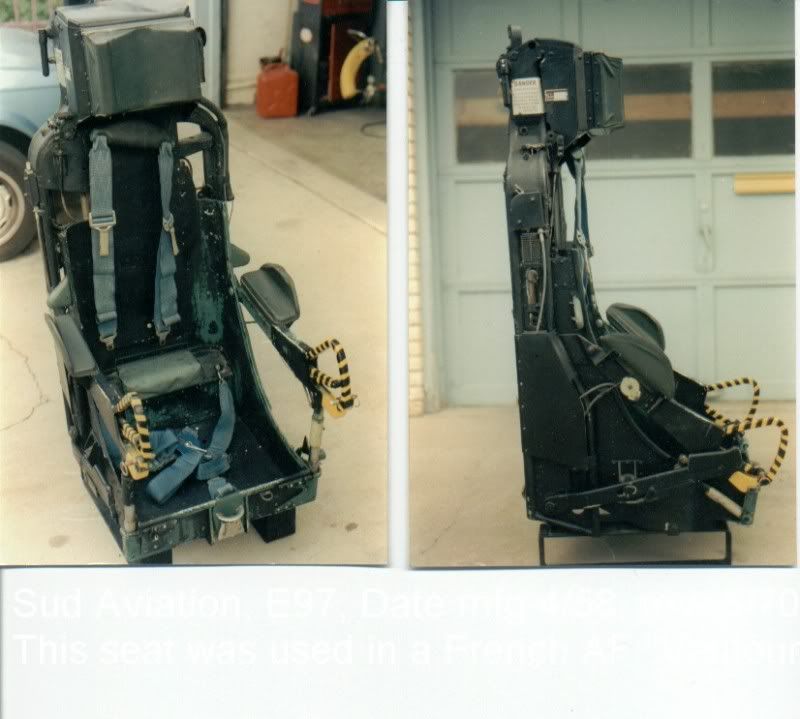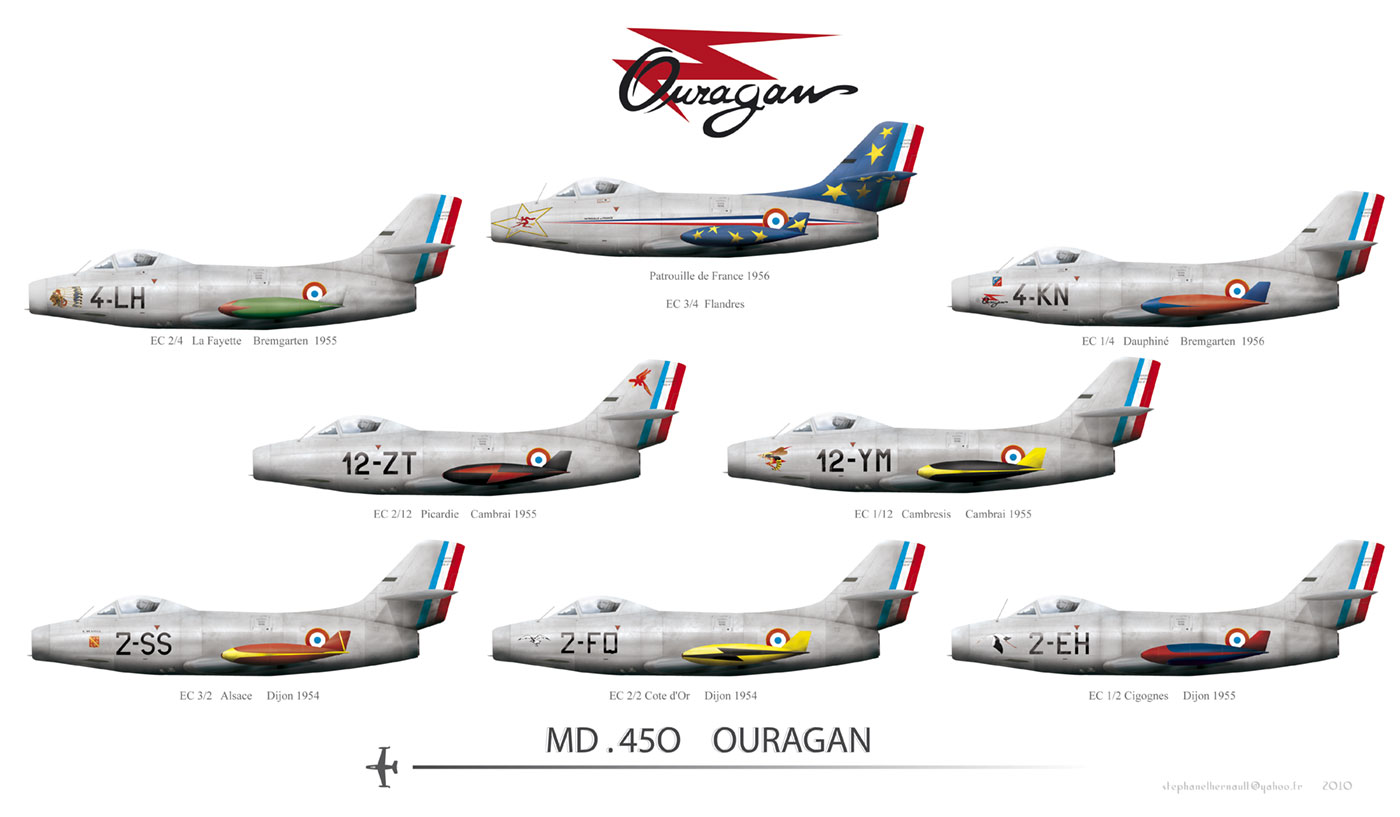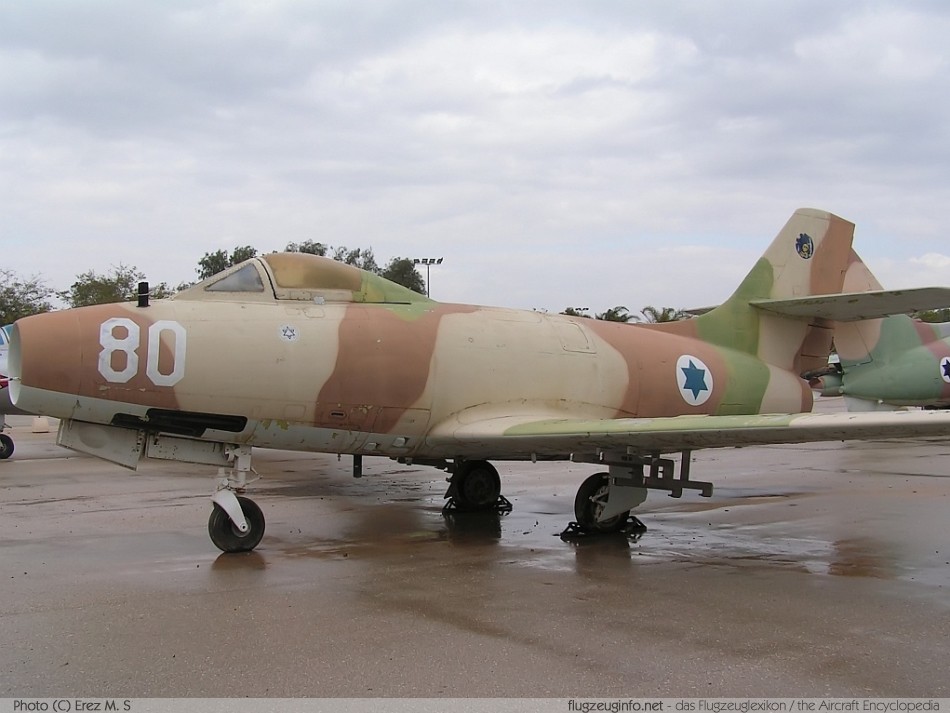Nice and missed early jet.



General characteristics
Crew: One
Length: 10.73 m (35 ft 2 in)
Wingspan: 13.16 m (43 ft 2 in)
Height: 4.14 m (13 ft 7 in)
Wing area: 23.8 m² (256.2 ft²)
Aspect ratio: 7.3:1
Empty weight: 4 142 kg (9,132 lb)
Loaded weight: 7 404 kg (16,323 lb)
Max. takeoff weight: 7 900 kg (17,416 lb)
Powerplant: 1 × Rolls-Royce Nene 104B turbojet, 22.2 kN (4,990 lbf)
Performance
Never exceed speed: Mach 0.83
Maximum speed: 940 km/h (508 knots, 584 mph) (Mach 0.76) at sea level
Cruise speed: 750 km/h (405 knots, 465 mph)
Combat radius: 450 km (245 nm, 280 mi)
Ferry range: 920 km (500 nm, 570 mi)
Service ceiling: 13 000 m (42,650 ft)
Rate of climb: 38 m/s (7,480 ft/min)
Takeoff distance: 783 m (2,570 ft)
Landing distance: 910 m (2,985 ft)
Armament
Guns: 4× 20 mm Hispano-Suiza HS.404 cannon with 125 rounds per gun
Rockets: 16× 105 mm (4.1 in) Brandt T-10 air-to-ground unguided rockets; or, 2× Matra rocket pods with 18× SNEB 68 mm rockets each
Bombs: 2,270 kg (5,000 lb) of payload on four external hardpoints, including a variety of unguided iron bombs such as 2× 454 kg (1,000 lb) bombs or 2× 458 liter (121 US gallon) napalm bombs or Drop tanks for extended range.


Cockpit

 http://picasaweb.google.com/107238265313281486528/AircraftOfTheMuseumMD450Ouragan?gsessionid=QAGDdTJ_Gn9h08LolwAYQw#
http://picasaweb.google.com/107238265313281486528/AircraftOfTheMuseumMD450Ouragan?gsessionid=QAGDdTJ_Gn9h08LolwAYQw# http://florent1973.free.fr/FrenchAirWings/images/img_walarounds/avions/Ouragan/http://florent1973.free.fr/FrenchAirWings/francais/walk%20around/avions/Ouragan/w_Ouragan_nez2.htmhttp://scalemodels.ru/modules/photo/viewcat_cid_452.htmlhttp://simhq.net/forum/ubbthreads.php/topics/2470945/MD_450_Ouragan_cockpit_up_at_C.html
http://florent1973.free.fr/FrenchAirWings/images/img_walarounds/avions/Ouragan/http://florent1973.free.fr/FrenchAirWings/francais/walk%20around/avions/Ouragan/w_Ouragan_nez2.htmhttp://scalemodels.ru/modules/photo/viewcat_cid_452.htmlhttp://simhq.net/forum/ubbthreads.php/topics/2470945/MD_450_Ouragan_cockpit_up_at_C.html
Armee de l'Air
In August 1950, before delivery of the first pre-production aircraft, the French government placed an order for 150 Ouragans, although the initial order was to have been 850 Ouragans. Armee de l'Air would subsequently order 200 additional Ouragans, with Dassault being strained to build them as fast as possible.[citation needed]
The first production Ouragan flew on 5 December 1951. The type entered service with the French Air Force in 1952, replacing the British De Havilland Vampire. The first 50 Ouragans were built as M.D.450A with the Nene 102 engine; the rest were M.D.450B with a Hispano-Suiza-built Nene 104B engine, lighter than the Nene 102 and with slightly greater thrust. Wingtip fuel tanks were fitted as standard in both variants.
MD450 Ouragan on display with wingtip fuel tanks.Pilots found the Ouragan to be generally pleasant to fly and a stable gun and rocket platform, although due to its short-coupled fuselage, the aircraft had a tendency to snap into a spin in tight turns.[citation needed] However, for two years, the Ouragan successfully performed with la Patrouille de France aerobatic team.
Several production Ouragans were modified for rough field operation, single-wheel main gear changed to a two-wheel configuration fitted with low pressure tires, retracting into a fairing added under the wing roots. These aircraft were also fitted with brake parachutes. This configuration was intended for combat operations in Algeria, and aircraft so fitted were nicknamed "Barougans", from the Arabic word baroud (battle). However, nothing came of the project, and some of the test aircraft were reconverted back to standard Ouragan configuration.[citation needed]
In French service, the Dassault Mystère IV completely replaced the Ouragan by 1961.
India
On 25 June 1953, India ordered 71 Ouragans with the slightly uprated Nene 105 engine, with deliveries starting that year and completed in March 1954. An additional order for 33 second-hand Ouragans in March 1957 brought the total to 104. Selection of the Dassault Ouragan fighter from France at this time reflected the decision to initiate diversification of supply sources. The Indians named the aircraft Toofani (Hindi: Hurricane).
The Indian Toofanis faced combat in 1961, when they performed air strikes against the Portuguese territory of Diu on the western coast of the indian sub-continent. They were also used in ground attack missions against anti-government rebels in Assam and Nagaland, and in 1962 for reconnaissance missions in the Sino-Indian War. One Toofani strayed over the border with Pakistan on 24 April 1965, and was forced to land by a pair of Pakistani Sabres. While the pilot was returned to India, the aircraft was retained and ended up being displayed at the Pakistan Air Force Museum at Peshawar.
As was the case in France, the Ouragan started to be replaced in front-line service by the Mystère IVA in 1957, being withdrawn fully from front line service in 1965, although it continued in use for some years as advanced trainer and Target Tug.

Israel
Ouragan at the Israeli Air Force Museum in Hatzerim.In contrast to France and India, the Israeli Air Force was an enthusiastic Ouragan user, as Arab air forces were buying advanced Russian arms, such as the MiG-15 fighter. Seeking to augment its jet aircraft force of British Gloster Meteors, IAF initially considered French Dassault Mystère IIC and Canadian-built F-86 Sabre Mk.6 fighters. Due to development problems with the Mystère and a Canadian embargo on the Sabres, the order was changed to Mystère IVAs, with a batch of Ouragans purchased as a stop-gap measure. By 1955, the IAF had received at least 75 aircraft, comprising a mix of newly-built and retired French Air Force examples. The Israeli Ouragans were assigned to close support operations, since they could not match the performance of Egyptian MiG-15s.
Israeli Ouragans entered combat on 12 April 1956, shooting down an Egyptian Vampire. At the onset of the Suez Crisis on 29 October 1956, Ouragans shot down an additional four Vampires. The two documented encounters with Soviet Mikoyan-Gurevich MiG-15 fighters (also powered by the Nene engine but with a more modern swept wing) ended with one Ouragan surviving several 37 mm (1.46 in) cannon hits to fly the next day and one MiG-15 being heavily damaged after it entered a turning dogfight with the Ouragans.[8] The poor training of the Egyptian pilots who were consistently unable to realize their advantage in numbers as well as the MiG-15's speed and climb characteristics helped Ouragans to survive despite their inferior performance. On 31 October, a pair of Ouragans armed with rockets strafed the Egyptian destroyer Ibrahim el Awal (ex-HMS Mendip), resulting in the capture of the ship.
The Ouragans were relegated to advanced training shortly after the Suez Crisis, although they saw more combat in the 1967 Six-Day War. In 1975, the IAF sold 18 Ouragans to El Salvador, where they remained in service until the late 1980s.


El Salvador
In the wake of the Football War of 1969, El Salvador began a concerted push to modernize its air force.[citation needed] Unable to buy combat aircraft from the United States due to a US government arms embargo, the Salvadorans bought 18 surplus Israeli Ouragans on the international arms market. These aircraft were refurbished by the Israelis and were delivered to El Salvador between 1973 and 1978.


El Salvador's
Ouragans saw extensive combat during the Salvadoran Civil War of 1980-1992. Salvadoran Ouragans flew strike missions against communist FMLN forces, operating from Ilopango airport located near the capital city of San Salvador. As El Salvador is not a large country and combat radius was not a pressing concern, Salvadoran Ouragans in combat usually operated with their wingtip fuel tanks removed in order to save weight and allow for greater weapons loads.
An FMLN sapper attack against Ilopango in 1982 destroyed several Ouragans and accelerated the push to supplant, and eventually replace, the Ouragans with American-made Cessna A-37 Dragonfly aircraft, which were made available after the Reagan Administration dropped the arms embargo. The remaining Ouragans served on for several more years, but were all retired by war's end.
Salvadoran Ouragans have been pictured in several camouflage schemes, and it is possible that during the war the Ouragan fleet operated in colors that were never completely standardized.[citation needed]
At least one survivor of El Salvador's Ouragan fleet is currently on static display, at Ilopango.




